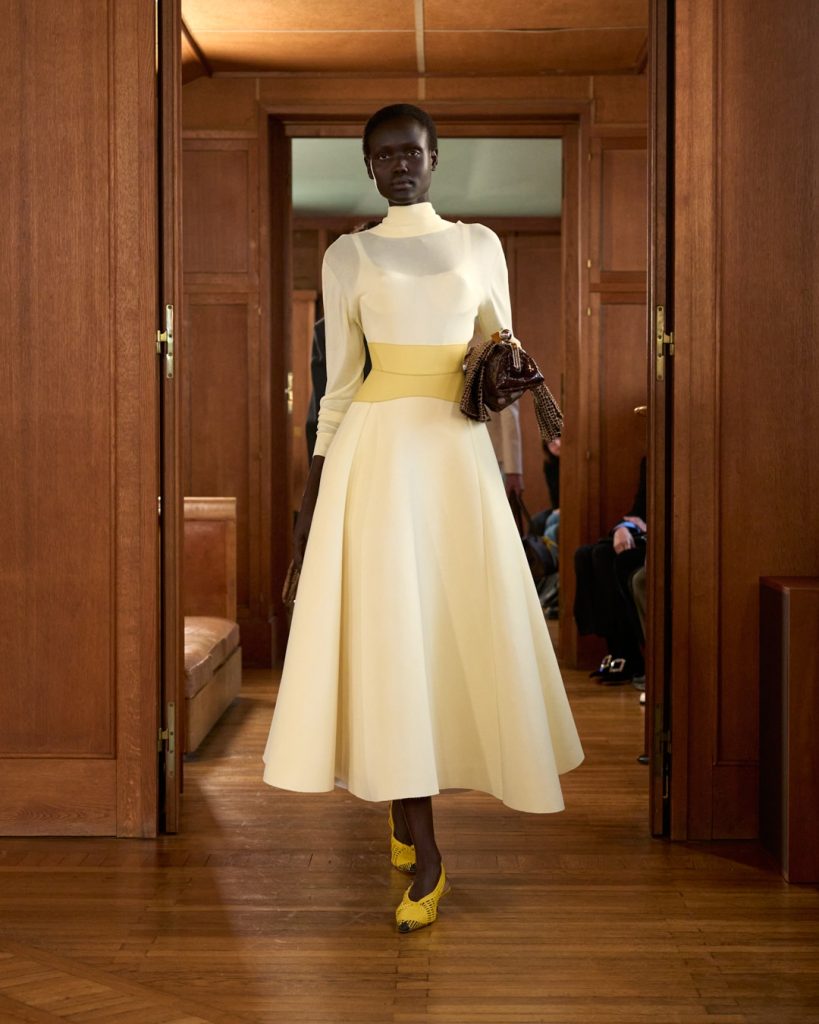
“Are fashion runways made for social media?” We raise this question after every fashion season. Fashion brands bet the bottom dollar on the set-up, the concept, or even ride on the coattails of viral trends on social media—even though by the time these collections hit the store, the trend might have hit an inflection point—but why is fashion putting its sales and relevancy on the virality on social media?

“It seems that we are directed by algorithms, so anything we like and anything we know is because other people are instilling it into us,” Miuccia Prada shared in the Prada Spring/Summer 2025 backstage interview with Vogue Runway. She showcased a hodgepodge collection that freewheeled without a core concept or storyline to grip onto. The chatter went on with the audience raising their brows: where is the wow and pow? But Prada and Raf Simons asked, can garments just be garments? It was music to our ears. The Spring/Summer of 2025 collections steered away from micro trends—social media fatigue is real—or any of the “core”. Let the garments speak, let the fabrics or the tailoring do the storytelling, directing or even urging us to read the underpinning tone of fashion: Soft Power—an instrument that moulds and forms cultural opinions—also rather literally, a tension between the New Romance and the comeback of power dressing.

Textiles such as chiffon and organza are utilised to create flowing layers that put forth the ethereality. Loewe stood out with crinoline dresses, minus the corset and added pockets. These under hoops are covered with floral-printed sheer layers that bounce light. The contrast between vulnerability and resilience is point-blank—an aptly done homage to the revered craftsmanship the Spanish house writes home about, something Anderson never segues away from in his ten-year tenure at Loewe. Cinephiles will recognise that Naked Dressing—an umbrella term given to gowns that are either sheer or form-fitting—was favoured by starlets on the red carpet, from Clara Bow to Cher. Part of these decisions were made to grab attention, especially in an algorithmic world, but we cannot dismiss the predilection of these body-celebrating looks which also signifies society’s current state of mind: to reveal the real self.
It’s been a recurring theme for the past few years, proving that the world has been—despite being shilly-shallying about freeing the nips—yearning to be transparent, be it cutting ties with filtered reality on the virtual world or freeing ourselves from the oppressive sociopolitical situation. The sheer capes in Chanel for example, embody the theme of freedom of flight seamlessly. Sportmax, Dior, McQueen, and Dolce & Gabbana also flaunted their artisanship as they found ways to weave delicate fabrics and their brand identity.



From the outlook, designers collectively agreed to move from Brat Green and the fiery “Paint the Town Red” towards a softer direction with hues of blush. A lighter shade of yellow is spotted in the sophomore collection by Pelagia Kolotouros for the tennis-centric brand, Lacoste, as well as Luar’s collection that pays homage to the drag scene and nightlife in New York City. This buttery shade has been associated with Spring since last year—Loewe and Jacquemus featured the colour in their Spring/Summer 2024. The hot Barbie pink too is replaced with a subtler tone as seen on Chanel, Bottega Veneta, Alaïa and Chloé. We view it as a palate-cleanser to the geopolitical tensions and the socio-economic turmoil, these Pantone New Age pastels lead the season with their aerated characteristic that appears to be meditative, calm and
child-like.


Words like ultra-femininity or femininomenon have been the grist to the mill in women empowerment but “you don’t have to renounce your strength to be feminine” commented Nicole Phelps, Director of Vogue Runway. She was referring to the Dior Spring/Summer 2025 show that pulled up a collection featuring athletic references like bodysuits, knee-gaiters, and gladiator footwear inspired by Amazonian female warriors. Elsewhere, the suit earned itself a moniker as the armour of the modern day, be it a good old Saville Row tailoring or a deconstructed blazer that dominated the runways a few years ago. Regardless of the era, well-tailored suits are perpetually held in high regard as the ultimate classic. After the resurgence of the nineties and noughties, it’s about time for the 80s’ power dressing to come back in full
force. Fashion is cyclical, after all.


From the take-it-to-the-street Balenciaga to experimental leathermaking at Bottega Veneta and Jil Sander’s play on proportion, square-shouldered suits claimed its throne on the runway. More than its visual appeal that boosts confidence and authority, the boxy silhouette resurfaced several times in fashion history to break gendered clothing boundaries over and over again, coinciding with the sociopolitical situation that calls for equality. It’s Saint Laurent that clinched the deal and hammered the idea with a collection that gave the founding designer Yves Saint Laurent a literal nod: the wedge-shaped suit jacket, pinstripe button-up, and trousers of a delicious length with neckties tucked in, spick and span.
“What happens when one takes all the noise away?” Jonathan Anderson asked. The domain has never been this crowded with new talents, audiences, and markets to discover. The clockwork of trends is ticking absurdly fast and the world seems to have missed the groundwork of fashion to mirror society’s psyche and the capability to envision. As Phelps puts it, “The best designers are the ones who not only respond to and mirror their times but provide us with some sort of projection, a future vision for how fashion—and the greater culture—could be.”
This story first appeared on GRAZIA Malaysia March 2025 Issue.
READ MORE
In Devastating News, Jonathan Anderson Is Officially Leaving Loewe
PFW: Up In The Air At Chanel Spring/Summer 2025
Lacoste Is Bringing Tennis to the Seaside for Spring/Summer 2025
